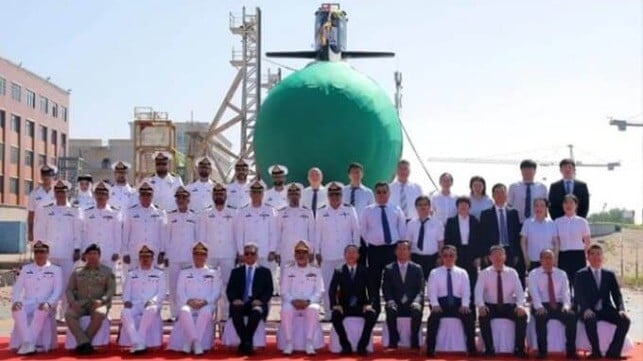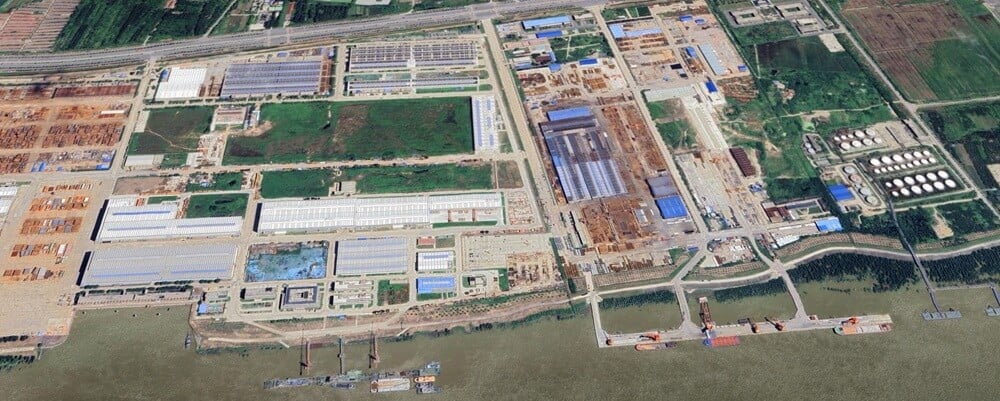Pakistan Receives its Third Chinese-Built Submarine

The Pakistani Navy has received its third Hangor-class submarine in a ceremony performed at the new shipyard of Wuchang Shipbuilding in Shuangliu, China on August 14. The main Wuchang shipyard used to be located in downtown Wuhan some 20 miles away, on land which is now being redeveloped. But the new shipyard is still about 400 miles from the coast, so the submarine’s first voyage will take it down the Yangtze River to Shanghai.

The Wuchang Shipbuilding yard at Shuangliu (30.5881N 114.6813E) (© Google, Airbus, CNES/Airbus, Maxar Technologies)
Pakistan has ordered four Hangor-class submarines, based on the Chinese Type 039B Yuan Class. There are about 17 Type 039s (including earlier versions) already in service with the People’s Liberation Army Navy (PLAN). The second Pakistani submarine was handed over in March. All four submarines for Pakistan originally were to have been handed over by 2023, so the project is somewhat delayed.
A further four submarines are to be constructed by Karachi Shipyard & Engineering Works, with deliveries to be completed by 2028; the keel for the second submarine was laid in February 2024. Karachi Shipyard built Pakistan’s Agosta 90B Khalid-class boats under license from France between 2000-06, which the Hangor Class submarines are due to supersede. Hence Karachi Shipyards already has relevant expertise. Nonetheless, completing the build of the boats in Karachi will represent a technical step up, particularly as the Chinese CHD620 engine has presented noise vulnerabilities and its integration underwater is not yet proven.
The last three of the earlier Khalid-class boats have air-independent propulsion. They have had mid-service systems upgrades in Turkish shipyards, but nonetheless are reaching the end of their service life. The Pakistani Navy urgently needs the capability upgrade and to get its new Hangor-class submarines into service. Whereas the Agosta design was primarily intended for coastal operations, the new submarines should be able range further.
A realistic counter-poise is needed to deter Indian Navy projections into the northern Arabian Sea. During the conflict between the two nations in early May, Pakistan had only a limited ability to counter the forward deployment of the two Indian Navy aircraft carriers INS Vikrant (R11) and INS Vikramaditya (R33), effectively restricting the Pakistani Navy to adopt a defensive posture in coastal waters. The refreshed capability now means that the Pakistan Navy may be able to recreate its success in the 1971 war, when the Pakistani submarine PNS Hangor (S-131), after which the new class of submarines is named, managed to sink the Indian frigate INS Khukri (F149) and disable a second, INS Kirpan (F144) about 40 miles off the coast of Gujarat.
However, with India having attack submarines of its own, as well as a substantial force of Poseidon P-8I anti-submarine aircraft, the new Pakistani boats will need to be technically mature, stealthy and handled skillfully to pose a realistic counter. Any technical weaknesses in the design will make it vulnerable to the formidable anti-submarine force that it will be up against.
The new Hangor-class boats will almost certainly be able to launch cruise missiles, as can the PLAN Yuan-class submarines from which they were developed. Pakistan is known to have developed the 600-mile range Babur-1B cruise missile, reverse-engineered from an intact Tomahawk missile recovered from Afghanistan. Pakistan also tested a nuclear warhead-capable Babur-III from an undersea launch platform in 2017 and 2018.
The earlier Chinese Type 039A Yuan-class design is the basis of the three S62T submarines being procured by the Royal Thai Navy, whose in-service date is much delayed because of the challenges of adopting the CHD620 engine in place of the originally-specified MTU396 engine.
